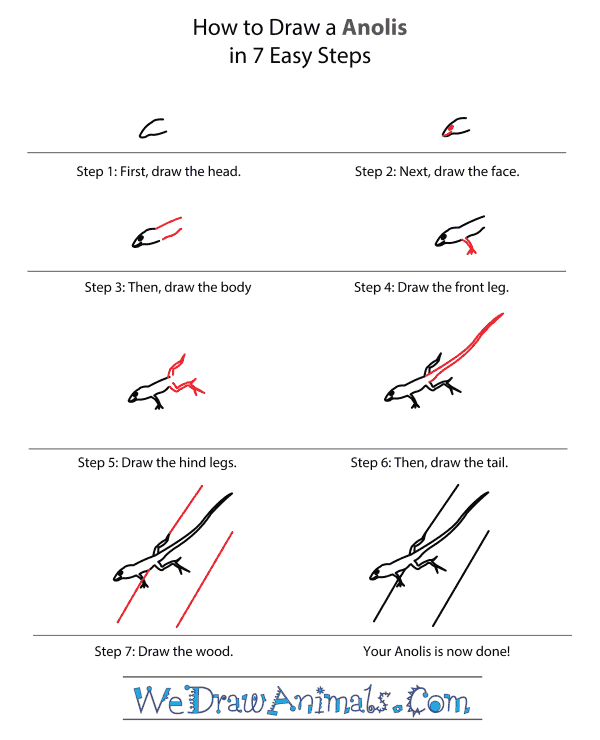In this quick tutorial you'll learn how to draw an Anolis in 7 easy steps - great for kids and novice artists.
The images above represent how your finished drawing is going to look and the steps involved.
Below are the individual steps - you can click on each one for a High Resolution printable PDF version.
At the bottom you can read some interesting facts about the Anolis.
Make sure you also check out any of the hundreds of drawing tutorials grouped by category.
How to Draw an Anolis - Step-by-Step Tutorial
Step 1: Let's start our small lizard with the head - draw a tiny oval shape with a very slight indent.
Step 2: Draw a circle for the eye and a line for the mouth.
Step 3: Now let's draw the body - it's simple - just make two straight lines and leave two gaps.
Step 4: In the first smaller gap, draw the front leg with a three-digit foot.
Step 5: Now draw both back legs in a bent manner, pointing them towards the back, and giging the feet three digits.
Step 6: Almost done - draw the tail and narrow it towards the end. Make sure it is longer than the anolis' body!
Step 7: Lastly, draw two straight, diagonal lines for the tree.
Interesting Facts about the Anolis
The anolis (Anolis pogus) is a type of lizard that lives in the Caribbean island. These anoles prefer to stay lower on the ground, and do not like to be on more exposed, higher branches.
Did you know?
- The anolis pogus is more commonly known as the bearded anole.
- Males can grow to be about two inches long and are usually light brown to orange brown. Females are generally the same color as males, but they are duller and usually marked with a stripe down their back.
- This species is mostly confined to one area of about 50 miles on the island of St. Martin.
- They share much of their area with the Anguilla bank anole, but they prefer higher perches than the bearded anole.
- Because of the small number and area of this species, the bearded anole is considered vulnerable, which means it is close to becoming a threatened species.
Lesson plan note: The bearded anole shares its habitat with another anole, but where they like to be, or their niches, are different. Discuss how these animals might evolve and grow to live differently so they can exist together.








